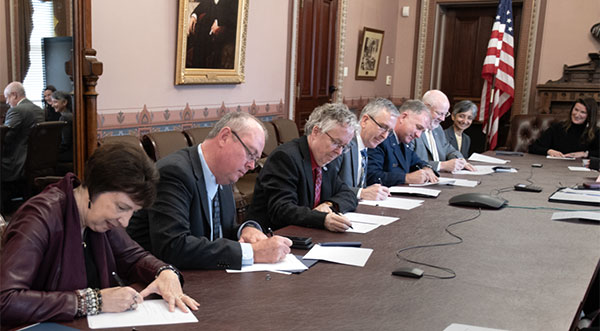Space Weather Follow-On is a NOAA environmental satellite program

BREVARD COUNTY, FLORIDA – Space weather scientists at NOAA and experts across the government celebrated a new collaborative effort to improve space weather forecasts and services to mitigate the impacts of space weather.
The timing is critical as we approach what is already proving to be an active Solar Cycle 25.
NOAA’s Assistant Administrator for Weather Services and National Weather Service Director Ken Graham and NOAA’s Assistant Administrator for Satellite and Information Services Stephen Volz joined leaders from other federal agencies to sign a historic Memorandum of Agreement (MOA) designed to encourage and support collaboration among agencies to advance the nation’s space weather research and operations capabilities.
The Dec. 7 event was hosted in the Eisenhower Executive Office Building by the White House Office of Science and Technology Policy.
“Having this interagency agreement will lead to actions to improve space weather forecasts and predictions,” said Ken Graham, director of NOAA’s National Weather Service, who signed the MOA.
“We have a shared goal and that is to enhance our nation’s space weather preparedness and that can only happen through better coordination and expanding on existing efforts to improve space weather observations, research and modeling.”
The absence of a formal interagency process for the transition of space weather research-to-operations and operations-to-research has been long recognized as a critical gap in evolving the nation’s ability to improve space weather forecasts and warnings.
This agreement provides a structure through which NOAA, NASA, the National Science Foundation (NSF), and the Department of the Air Force (DAF) can coordinate and collaborate on space weather research-to-operations-to-research.
This includes working together to transition capabilities such as models, observations, forecast applications, techniques, and technology- from research into operations. It also means providing and acknowledging feedback and sharing of operational data and information on space weather impacts on infrastructure.
“Strengthening collaborations and coordination across the federal government in transitioning space weather research to operations is critical for minimizing and mitigating the potential consequences of space weather events, and for supporting the growing commercial space enterprise,” said Stephen Volz, director of NOAA’s Satellite and Information Service.
The need for a framework was identified by the White House Space Weather Operations, Research, and Mitigation Subcommittee. It was identified as a critical gap in the nation’s ability to improve space weather forecasts and warnings to support both our important federal space activities as well as the rapidly expanding commercial space economy.
To close the gap, the Promoting Research and Observations of Space Weather to Improve the Forecasting of Tomorrow (PROSWIFT) Act (Public Law No: 116-181, Oct 2020) directs federal agencies to develop formal mechanisms to transition space weather research models and capabilities to operations.
NOAA’s Office of Space Weather Observations develops and deploys advanced operational satellite systems that monitor space weather and safeguard society.
The Space Weather Follow-On is a NOAA environmental satellite program that collects space weather measurements to predict and minimize space weather impacts here on Earth.
NOAA’s Space Weather Prediction Center safeguards society with actionable space weather information. It is the official civilian source for space weather forecasts, watches, warnings, alerts, and impacts.
Their forecasts inform electric grid operators, satellite operators, airlines, and others about the potential impacts of space weather so they can take action and protect infrastructure and the public. Visit www.spaceweather.gov for updates.
CLICK HERE FOR BREVARD COUNTY NEWS
The post National Oceanic and Atmospheric Administration Creates New Path for Space Weather Collaboration appeared first on Space Coast Daily.

